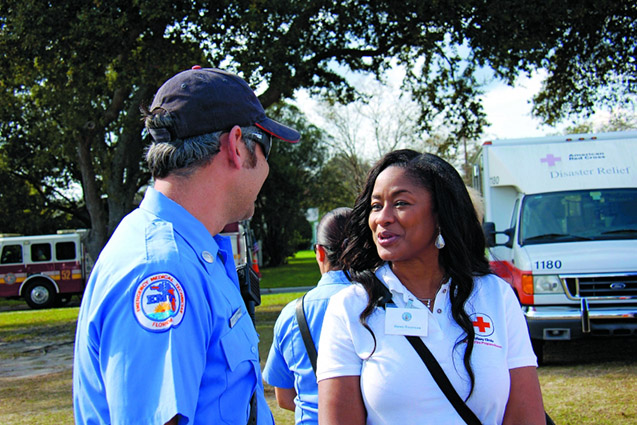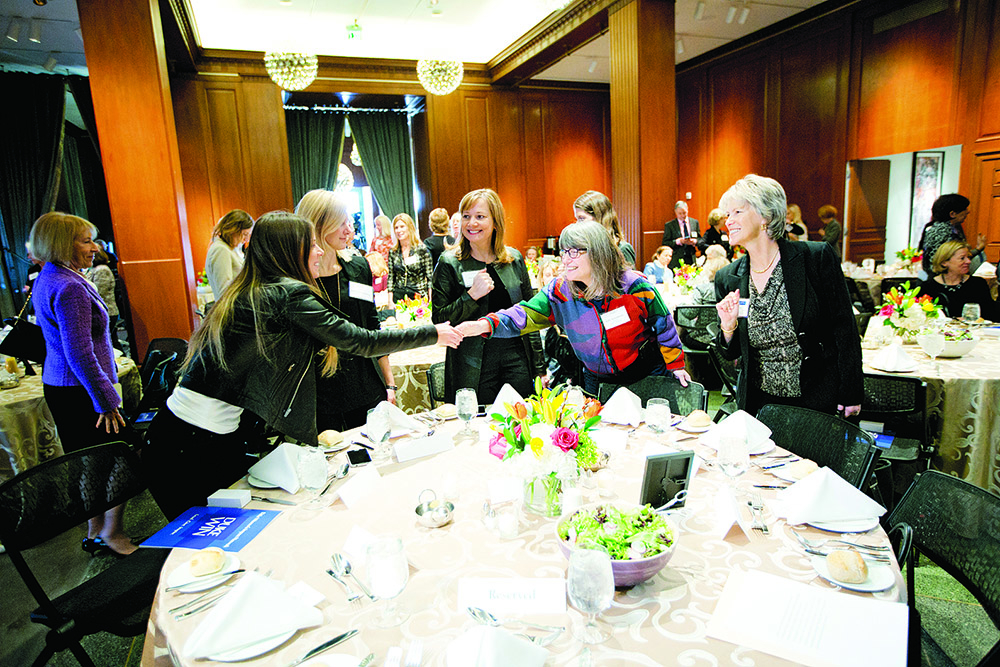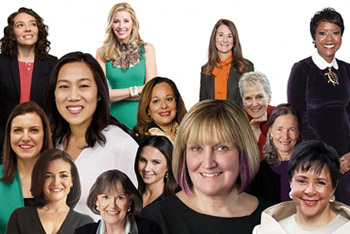
IN HER NAME: United Way of Salt Lake’s Zenia Frendt leads the charity’s Women’s Leadership Council, which paid to open this community center in an apartment complex that’s home to many refugees. The center features a painting of its namesake, Hser Ner Moo, a Burmese girl murdered in the complex.
In late 2014, executives at United Way of Greater Los Angeles found a startling statistic in data from United Way Worldwide. Fundraising across the federated charity was mostly flat compared to a decade prior. Donations via women’s affinity groups, however, had increased more than 170 percent.
United Way’s Los Angeles affiliate already had its own Women’s Leadership Council. In name, anyway.
“Donors didn’t necessarily even know they were a part of it,” says Rebecca Edwards, a major-gifts officer with the chapter. “They just got different stationery with their thank-you note.”
Ms. Edwards’s bosses assigned her full time to breathe life into the group. She studied research on women’s giving patterns and models at other organizations. She interviewed active donors and women she and her colleagues wished would give. She assessed the local competition, and she mapped out a five-year plan.
The reboot of the council kicked off last summer, with 12 months of networking and volunteer events carefully calibrated to immerse women in the issues they will help tackle. Not even a year later, membership — with its minimum $2,500 donation — is nearing 230 women, including 100 newcomers.
Thank-you notes often go out addressed first, and sometimes only, to the husband.
Ms. Edwards’s original goal? Thirty additional members.
What is taking place in Southern California is just one case study in an expanding body of evidence that shows women primed to wield philanthropic power as never before. Their growing clout is the result of a supernova of demographic changes that distinguish 21st-century women from those who came before: greater earned incomes, more wealth, increased decision-making authority at home, and longer lives, just for starters.
Still, academics and nonprofit leaders say groups like United Way of Greater Los Angeles remain the minority. Nonprofits have been slow to adapt to the new reality. Blocking the way for many are holdover sexism, entrenched and outdated fundraising tactics, inflexible software systems, and boards packed with men.
The stakes are high. Virginia Merkel, an Indianapolis philanthropist who recruits women donors for the American Red Cross, calls it a “zero-sum game”: “If you don’t engage those women, somebody else is going to take their money.”

ON THE JOB — AND GIVING: Dawn Bozeman works with emergency personnel to install smoke detectors. She is a member of a Red Cross women’s-giving circle that raised $7.7 million last year, more than two-and-a-half times what it collected in 2007.
Women vs. Men
Philanthropy can seem like a man’s world. It’s mostly men making the eight- and nine-figure donations that grab headlines. Women, it would appear, simply don’t earn enough money to matter much. There are just 22 women CEOs at Fortune 500 companies, and women take home about 78 cents for every dollar earned by men.
Yet things are changing as women make gains in education, the workplace, and finances. They control more than half of personal wealth in the United States, or about $14 trillion. With an average life expectancy of 81 years, nearly five years longer than that of men, they will inherit from parents and spouses trillions of dollars in the coming decades.
And by some measures, women are already more generous than men. Research by the Women’s Philanthropy Institute at Indiana University’s Lilly Family School of Philanthropy found that female-headed households give more than those headed by males at almost every income level.
Women also give differently than men, research shows. They seek a deeper level of involvement in an organization or cause and have a special affinity for communal philanthropy. Witness the explosive growth in women’s giving circles — a model in which money is pooled and doled out collectively — such as Impact 100. Founded in Cincinnati in 2001 with a $1,000 minimum donation, the group has grown to include 35 affiliates that spur millions in donations yearly.
“For me, this is what defines women’s philanthropy,” says Jacki Zehner, chief engagement officer of Women Moving Millions, a donor community that pushes women to give at least $1 million to women’s causes. “It is not about sitting on your own pile of money and deciding who is worthy. It is about being in partnership with the organizations you give to and giving in community with others.”
Models for Revenue
The academics and nonprofit leaders who study women’s philanthropy have brandished these ideas and statistics for years, if not decades. And some have turned them into action.
United Way of Salt Lake launched its Women’s Leadership Council in 2005 with a bit of flair, staging the inaugural gathering at a landmark downtown restaurant that caters to the city’s male power brokers. Early members paid for a community center in an apartment complex in South Salt Lake, home to a large refugee population. Services included English and parenting classes, homework assistance, and mentorship.
Today the council has 225 members, including 47 of the original 60, says Zenia Frendt, the charity’s director of leadership giving. The minimum donation is $1,500. Last year the council raised $460,000, for a total of $2.6 million since its inception.
“There is no question that this is a successful model for increasing revenue,” Ms. Frendt says.
In recent years, the council’s work has expanded. Women donors pay for staff at South Salt Lake schools who connect poor children and families with health and other services. The philanthropists also support, and take direct part in, a mentorship program for at-risk teenagers that is being used as a national model.
“If you don’t engage those women, someone else is going to take their money.”
“I have found that when our women feel included in things, when they feel invited to things, when they feel thanked and welcomed and appreciated, they will be there and have your back,” Ms. Frendt says.
Women have become a key part of the larger growth strategy at United Way Worldwide. They are the charity’s fastest-growing donor segment, according to a spokeswoman, and 165 United Ways now have women’s groups.
Another major charity, the American Red Cross, started its women’s giving effort in 2006. The Tiffany Circle, which requires a $10,000 annual donation, is named after the stained-glass Tiffany windows at the charity’s national headquarters in Washington, commissioned for $10,000 by women on both sides of the Mason-Dixon line as an act of reconciliation after the Civil War.
Ms. Merkel, the Indiana philanthropist, started recruiting Tiffany Circle members in 2008 while serving as board chair of her regional Red Cross. She describes it as a calculated move. Many of her fellow board members were donating about $1,500 a year. The Tiffany Circle was a way to boost gifts and give women donors more cachet with the organization.
Appealing to Women Donors
Research shows that women, whether wealthy or not, outpace men when it comes to charitable giving. We’ve collected here some of our best information on female donors.
- Women to Watch
- Charity’s Push to Get Women Donors More Actively Involved Yields Big Gifts
- What Women (Donors) Want: Cultivation and Stewardship Advice for Fundraisers
- How a Program for Women Donors Re-Energized Its Marketing Materials
Today, 12 women, three of them Tiffany Circle members, are on the 25-person Indianapolis Red Cross board. When Ms. Merkel got involved in the early 1990s there were just three female board members. Statewide, there are 25 Tiffany Circle members.
“I looked at it as an opportunity to raise money for the Red Cross and to create a new group of donors, but also to elevate women into positions of leadership,” Ms. Merkel says.
Nationwide, Tiffany Circle membership has climbed to about 800, with donations totaling $7.7 million last year, up from $3 million in 2007.
‘Quite Significant Gifts’
In 2012, the foundation at the College of William and Mary set in motion a yearlong study to determine what it would take to be best in class in fundraising from women, says Matthew Lambert, vice president for development. Leadership boards across the institution skewed heavily male. Men made up roughly three-quarters of donors in development portfolios. And gift officers regularly scheduled midday meetings in business corridors, meaning critical face-to-face time often excluded prospects’ spouses. Women were donating more frequently than men, but the amounts were smaller — alumni were outgiving alumnae by about $3.5 million per year.
“Anyone in my role as vice president overseeing an advancement shop is crazy to think you can continue doing the same things the same way and get anything other than the same results,” Mr. Lambert says.
William and Mary created a position dedicated to alumnae activities with the goal of engaging women and getting them into campus leadership. It is retraining gifts officers based on research about why women give. And it established regional development offices in Washington, New York, and California, all led by women. Being local, rather than parachuting in for one- or two-day fundraising swings, they have the time and flexibility to schedule meetings when and where both spouses can participate.

MONEY ON THE TABLE: Duke’s Women’s Impact Network gathered for the first time in February. The university aims to boost women’s giving by tens of millions of dollars.
Aided in part by such changes, the college has secured several “quite significant gifts” from women that it expects to announce this year, Mr. Lambert says. It is a “boneheaded mistake” for fundraisers to ignore the half of the population that, in many cases, has final decision-making power over couples’ wealth, he says.
Duke University, in concert with the public launch of a $3.25 billion capital campaign, took a hard look at the underrepresentation of women in its top donor ranks and board positions. The university found it was leaving tens of millions on the table. The average lifetime giving for women was about $8,000, while men gave $19,000. Among those who contributed $25,000 to $1 million over a lifetime, Duke projected $48 million in new gifts if alumnae giving rates could be raised to equal those for men. At the $1 million-plus level, it could reap an additional $144 million.
The university launched the Duke Women’s Impact Network Leadership Council, or Duke WIN, with a membership threshold of $100,000 in accumulated giving. In February, the university hosted a kickoff lunch, with Mary Barra, CEO of General Motors and the mother of a Duke student, as keynote speaker. Shortly before the event, Duke WIN Director Bridget Booher got a call from an alumna.
“I’m not yet at that $100,000 level, but I want to be so I can come to the lunch,” said the caller, who completed her donation shortly thereafter.
Little Progress
Despite such successes, nonprofits generally aren’t tapping the power of women. “I don’t think you could give a letter grade better than ‘C’ to most of the sector for the steps taken to incorporate women as volunteers and donors and put women in leadership positions,” says Gene Tempel, founding dean of Indiana University’s Lilly School.
The lack of progress is rooted in any number of outdated development-office mores, tools, and practices. Martha Taylor — who in 1988 helped start the Women’s Philanthropy Council at the University of Wisconsin, the first group for women donors in higher education — still sees marketing materials that don’t feature photos of women and capital-campaign events with few women speakers.
Another frequent culprit: fundraising software in which a donor profile defaults to a single-earner, male-headed household. In such systems, critical information about spouses and children is not appropriately recorded. Women do not get credit for gifts. Thank-you notes and other communications go out addressed first, and sometimes only, to the husband. On this front, “we fail, generally, as a profession,” Ms. Taylor says.
In some cases, one arm of an organization makes strides in its work with women even as another stumbles. Leaders at Indiana University are frank about this. By many measures, it has blazed a trail, starting a women’s leadership group in 2010 with the help of Laurie McRobbie, the wife of university President Michael McRobbie. Its 55 female and two male members have contributed or helped spur nearly $104 million in cash, pledges, and planned gifts, Ms. McRobbie calculates.
That didn’t stop Debra Mesch, director of the Lilly School’s Women’s Philanthropy Institute, from receiving a memorable fundraising call about three years ago from her own employer, Indiana University.
The student worker asked to speak to her husband. Ms. Mesch pointed out that she was the tenured faculty member in the house and that her spouse would have nothing to do with any potential donation.
Afterward, she recalls, “I picked up the phone and I called the [university’s] foundation, because if women do not let the leadership know at their foundations that this is happening, how are they ever going to know how to change the culture?”
Women often share stories with Ms. Mesch of fundraisers and nonprofits that call and, reading from Mad Men-era scripts, ask for the husband or the “decision maker of the household,” or that send thank-you notes addressed first to Mr. Donor when the wife wrote the check.
Insult women and it’s game over, Ms. Mesch says: “Why in the world would they want to contribute to you?”
Professional Expertise
At United Way of Greater Los Angeles, Ms. Edwards says, the early success of the revamped Women’s Leadership Council shows “there is a lot of hunger” among women donors to engage with each other on critical issues such as homelessness, education, and economic opportunity.
In the fall, more than 50 women volunteered to share their professional expertise in high-school classes studying topics related to their work. The feedback, Ms. Edwards says, was terrific. Women volunteers described moments of reverse mentoring, with students sharing their work and ideas.
In April, the United Way chapter drew 1,000 attendees to a daylong event centered on lifting women and girls out of poverty in Los Angeles County. Underwritten by corporate sponsors secured by the charity’s top female donors, the event raised $600,000. It also netted the women’s group 12 new members, all first-time United Way donors.
Elise Buik, the chapter’s first female chief executive, says today’s women philanthropists are giving nonprofits a glimpse into a future filled with fewer passive donors — those whose involvement begins and ends with a check — and more activist donors who want to build long-term relationships with groups and causes.
“If they are passionate, they are going to activate their own networks beyond even what we can do as staff,” Ms. Buik says.

